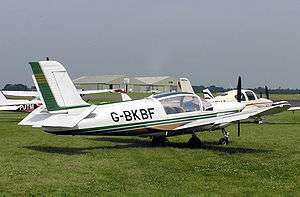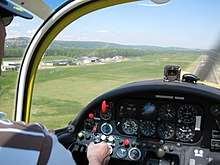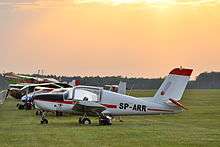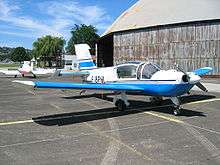SOCATA Rallye family
| Rallye | |
|---|---|
 | |
| Morane-Saulnier (Socata) Rallye Minerva MS.894A | |
| Role | Tourer/trainer aircraft |
| National origin | France |
| Manufacturer | SOCATA |
| First flight | 10 June 1959 |
| Introduction | 1961 |
| Produced | 1961–1982 |
| Number built | ~3,300[1] |
| Unit cost | |
The SOCATA Rallye (English: Rally) is a light aircraft that was manufactured by French aviation company SOCATA. It was originally developed during the 1950s by French aircraft manufacturer Morane-Saulnier as the MS.880.
On 10 June 1959, the prototype Rallye conducted the type's maiden flight; on 21 November 1961, type certification for the first production versions of the aircraft, designated as the MS.880B and more powerful MS.885, was awarded. Successive models of the Rallye were developed and manufactured; changes typically involved the installation of more powerful engines, structural strengthening, and the expansion of some of the flight control surfaces. As part of efforts to access the lucrative North American market, distributor agreements were formed with multiple US-based companies, such as the Waco Aircraft Company and BFA Aviation, to market, sell, and service the Rallye. These efforts, while not being trouble-free, provided valuable sales of the type.
During 1979, SOCATA (which Morane-Saulnier had previously merged into) decided to rename all of the Rallye series' various models, each being assigned their own individual Gallic names. During the early 1980s, the Rallye was eventually phased out of production in France in favour of the newer Socata TB series. During December 1984, the final SOCATA-built aircraft was delivered; the entire production run had covered approximately 3,300 aircraft. However, the Rallye continued to be produced under licence in Poland by aviation company PZL, which marketed their own models under the PZL Koliber (English: Hummingbird) name. On 18 April 1978, the first flight of a prototype Koliber occurred; quantity production of the type commenced in Poland during the following year.
Development
During 1958, in response to the launch of a French government competition seeking such an aircraft, French aviation company Morane-Saulnier decided to commence work upon the design of a new single-engined light aircraft, initially designated as the MS.880 Rallye Club. According to aerospace publication Flying Magazine, in comparison with other light aircraft of the era, was relatively slow-moving and cheap fixed-wing aircraft; specifically, the magazine lauded the Rallye as being available "for a price much lower than any true STOL [short takeoff and landing], four-place aircraft".[4] It featured a relatively simplistic design which enabled it to be provided at a highly affordable price to customers, which, along with the aircraft's capable STOL performance, was viewed as being a highly attractive selling point, particularly to customers within the North American market.[4]
On 10 June 1959, the prototype Rallye, powered by a 90 hp (67 kW) engine, conducted its maiden flight. On 21 November 1961, the first production versions of the aircraft, designated as the MS.880B and more powerful MS.885, received their type certification, clearing them to perform operational flights.[5] Thereafter, a range of improvements and alterations were progressively made upon the design as new models of the Rallye were introduced; typical advances included the adoption of more powerful engines, improved payload capability, and strengthened structure, the addition of wheel fairings, increased ground clearance for the propeller, expanded rudder and ailerons, and changes to the cockpit canopy arrangement.[3][6] During 1965, Morane-Saulnier became a part of Sud Aviation, which was subsequently rebranded as SOCATA during 1966.[7] The newly merged company continuing to manufacture the Rallye in large numbers through the remainder of the 1960s and through the 1970s.[1]
During the early 1960s, a distributor arrangement between Morane-Saulnier and the American Ohio-based Waco Aircraft Company was established regarding the marketing, sale, and servicing of the Rallye throughout the sizable and attractive North American market.[2] While the type was sold under the Waco name, the Rallye had little time to prove itself prior to Waco winding up its aviation activities during 1971, resulting in only a handful of aircraft being delivered under its oversight.[6] As a consequence of Waco's dissolution, third party aviation companies purchased the various leftover assets and continued to provide spare parts and services to American owners of the Rallye.[3]
In the early 1970s, Now York-based company BFA Aviation was appointed as the type's new distributor within North America.[4] BFA, via several subsidiaries of its parent company Aerocon Inc, performed the final assembly of the Rallye for those sold to American customers. The use of American suppliers within the aircraft's supply chain, such as the Franklin 6A-350-C1 engine, Hartzell or McCauley-built propellers, wheels, brakes, and some of the cockpit instrumentation, was made upon some models of the Rallye, such as the Minerva.[3] Under the initial arrangement, US-built components would be shipped across the Atlantic ocean to reach the facilities of Sud Aviation and its subsidiary companies in France for integration onto a French-built airframe which, following completion and initial test flights, would be disassembled into sections and conveyed to BFA Aviation in the United States for final assembly and sale; efforts to reduce unnecessary shipping and thus cost were explored.[3]
During 1979, SOCATA decided to embark upon a new production programme, one of the results of which being the renaming of the various models of Rallye series, each one receiving an individual, "more Gallic" name.[8] During the 1980s, the type was gradually superseded and phased out of production in France by the newer Socata TB series. During December 1984, the final Rallye of approximately 3,300 aircraft,[1] an armed R235 Guerrier model, was delivered.[9]
SOCATA's decision to terminate production in France was not the end of all manufacturing activity for the type however. During the 1970s, SOCATA had sold a license for production of the Rallye 100ST model to the Polish State aviation company PZL, which led to the aircraft being independently constructed in its facilities in Warsaw as the PZL Koliber (Humming Bird). On 18 April 1978, the first PZL-built aircraft performed its maiden flight. During 1979, quantity production of the Koliber commenced; an initial batch of ten aircraft was produced that year.[10]
During February 1994, type certification of the Koliber was granted by the American Federal Aviation Administration, clearing the Polish derivatives to be sold and operated within the North American market.[11] Shortly thereafter, a distributor arrangement was formed with Cadmus Corporation to market and service the Koliber in the Americas. Among its uses, the aircraft proved to be a good trainer, in part due to the generous visibility provided from its cockpit and forgiving flight characteristics.[12]
Design
The SOCATA Rallye is a single-engined, low-wing monoplane light aircraft, capable of STOL (short takeoff and landing) performance. While not considered to be a highly aesthetic vehicle, the Rallye is considered to be sound and functional aircraft; efforts were made upon later-built aircraft to improve the type's visual appeal and to clean up the exterior.[13] Composed of all metal construction, it is typically outfitted with a fixed tricycle landing gear, complete with an offset free-castering nosewheel and relatively closely spaced main gear;[14][3] however, an alternative landing gear configuration is used upon the 235 C model, which was provisioned with fixed tailwheel landing gear instead. Unusually, the landing gear of the Rallye is articulated in order to better withstand the sharp forces that are imposed during STOL landings.[3] Flying Magazine noted that the Rallye is "a very nice-landing aircraft".[15]
The Rallye is equipped with a cantilever wing, which incorporated interconnected full-span automatic leading edge slats, wide-chord slotted ailerons, and wide-span Fowler-type trailing edge flaps. The combination of full-span slats and large Fowler flaps provided the aircraft with its capable slow-speed flight performance.[4] Fuel is also internally carried within the wings.[16] According to Flying Magazine, the Rallye possessed a generous degree of controllability and was relatively forgiving to fly, being extremely difficult to mishandle to the point where effective control of the aircraft would be lost.[3] The aircraft is safe to fly at practically any piloting skill level. While the Rallye has fair manoeuvrability, such as during loops and rolls, the execution of aerobatic maneuvers is not officially approved by the manufacturer.[17]
The aircraft's power was provided from one of a range of progressively more powerful air-cooled engines; such as the early Rallye Cub model, which was powered by a single Continental O-200-A engine, capable of generating up to 100 hp (75 kW), while the newer Rallye 235 variant was furnished with a Lycoming O-540 engine, which provided a maximum of 235 hp (175 kW). The method for both the ignition and run-up of the engine were relatively conventional.[15] In order to achieve a substantial increase in performance, which is useful for the execution of a STOL takeoff run, weight minimisation efforts should be made, such as carrying as little fuel and payload as is reasonably possible.[15]

The Rallye was fitted with a bulbous cockpit, which was capable of accommodating two/three people in the basic lower-powered variants and up to four personnel within the more powerful models of the aircraft, some of which were designed to function as glider tugs and banner bearers.[18] During the 1970s, an enlarged derivative of the aircraft capable of seating up to eight people, commonly referred to as the Rallye 7, was under active development.[3] The canopy slides rearwards to provide access to and from the cockpit, aided by a step located just underneath the wing's trailing edge; on the ground. On the ground, the canopy should remain slightly open when occupied to allow for adequate airflow; in flight, the canopy can be left open at speed up to a maximum of 94 knots.[15][16]
The cockpit has been described as being relatively noisy, but also often praised for the provision of excellent external visibility; Flight Magazine stated that "It is almost like being in a four-place open cockpit plane". Typically, the Rallye would be furnished with dual flying controls, each being complete with their own control stick, upon which controls for the intercom would be often mounted.[15][16] While fully featured cockpit instrumentation was an available option to be installed upon the Rallye, the additional weight of this equipment would noticeably impact the aircraft's performance; thus, customers would have to weigh up the benefits of having superior flight performance or being able to make use of greater amount of cockpit features.[19]
Variants
French production
- MS.880
- Original production version. Powered by 100 hp (75 kW) Continental O-200. Two-seat aircraft.
- MS.881
- 105 hp (78 kW) Potez engine. 12 built.[5] Two-seat aircraft.
- MS.883
- 115 hp (86 kW) Lycoming engine. 77 built.[5] Two-seat aircraft.
- MS.885 Super Rallye
- Two/three-seat version; first flight 1 January 1961.[20] 145 hp (108 kW) Continental O-300 engine. 212 built.[5]
- MS.886
- 150 hp (110 kW) Lycoming engine. Three built.[5]
- MS.890 Rallye Commodore
- The first version to incorporate four-place seating.[20] 145 hp (108 kW) Continental engine. Eight built.[5]
- MS.892 Rallye Commodore 150
- Similar to the MS.890 but with 150 hp (110 kW) Lycoming 0-320 engine. Later designated Rallye 150.
- MS.893 Rallye Commodore 180
- 180 hp (130 kW) Lycoming O-360 engine. Later designated Rallye 180. Further redesignated SOCATA Gaillard or SOCATA Galérien (glider towing version).
- MS.894 Rallye Minerva
- 220 hp (160 kW) Franklin 6A-350 engine. Later designated Rallye 220. Sold as Waco Minerva in United States.
- Rallye 100
- Powered by 100 hp (75 kW) Rolls-Royce Continental O-200. Available in two-seat trainer/sport (100-S) stressed for aerobatics, four-seat tourer (100-T) or convertible two/four-seat version (100-TS).
- Rallye 125
- Four-seat version of 100-T, powered by 125 hp (93 kW) Lycoming O-235.
- Rallye 235
- Powered by 235 hp (175 kW) Lycoming O-540. Redesignated SOCATA Gabier.
- SOCATA Galopin
- Version of Rallye 100 powered by 110 hp (82 kW) Lycoming O-235. Original designation Rallye 110.[21] Can be operated as a three/four-seat aircraft if spins are prohibited. All the other variants beginning with the MS.890 are full four-seat aircraft.[22]
- SOCATA Garnement
- Improved version of Rallye 150, with 155 hp (116 kW) Lycoming 0-320.[21]
- SOCATA Gaucho
- Tailwheel agricultural aircraft.[21]
- SOCATA R235 Guerrier
- Military version of Gabier/Rallye 235.
- SOCATA Gaillard
- Rallye 180 renamed
- SOCATA Galérien
- Glider tug or banner-towing version of the Rallye 180
- SOCATA Gabier
- renamed Rallye 235
- Waco Minerva
- Sales of the Rallye Minerva in the USA
Polish production
- PZL-110 Koliber
 PZL-110 Koliber
PZL-110 Koliber - Initial licence production version powered by PZL licensed 116 hp (87 kW) Franklin 4A-235, based on Rallye 100 ST.[10] Production 32 aircraft.[23]
- PZL-110 Koliber 150
- 150 hp (110 kW) Lycoming O-320 engine.[23]
- PZL-110 Koliber 160
- 160 hp (120 kW) Lycoming O-320 engine.[23]
- PZL-111 Koliber 235
- 235 hp (175 kW) Lycoming O-520 engine.[23]
Operators
Military operators
Government civil operators
Aircraft on display
- City of Norwich Aviation Museum – Morane-Saulnier 880B Rallye Club[33]
Specifications (180 GT)

Data from Jane's All the World's Aircraft 1976–77[34]
General characteristics
- Crew: one pilot
- Capacity: three passengers
- Length: 7.24 m (23 ft 9 in)
- Wingspan: 9.74 m (31 ft 11 in)
- Height: 2.80 m (9 ft 2¼ in)
- Wing area: 12.3 m² (132 ft²)
- Empty weight: 570 kg (1,257 lb)
- Max. takeoff weight: 1,050 kg (2,315 lb)
- Powerplant: 1 × Lycoming O-360-A3A air cooled flat four piston engine, 134 kW (180 hp)
Performance
- Maximum speed: 240 km/h (129 knots, 149 mph)
- Cruise speed: 225 km/h (121 knots, 140 mph)
- Stall speed: 92 km/h (50 knots, 57.5 mph)
- Range: 1,300 km (702 nm, 807 mi)
- Service ceiling: 3,600 m (11,800 ft)
- Rate of climb: 3.85 m/s (758 ft/min)
- Wing loading: 85.4 kg/m² (17.5 lb/ft²)
- Power/mass: 0.13 kW/kg (0.078 hp/lb)
References
Citations
- 1 2 3 Donald 1994, p. 804.
- 1 2 Trammell 1971, pp. 35, 37.
- 1 2 3 4 5 6 7 8 9 Trammell 1971, p. 37.
- 1 2 3 4 Trammell 1971, p. 35.
- 1 2 3 4 5 6 Taylor 1976, p. 64.
- 1 2 "SOCATA 'Rallye'-Waco 'Minerva'," 30 November 1999, Plane & Pilot Magazine, Retrieved: 5 February 2017.
- ↑ The Society de Construction de Tourisme et d'Affaires. – pilotfriend.com.
- ↑ "Rallye History". Fly Rallye. Retrieved 3 August 2008.
- ↑ Taylor 1988, p. 84.
- 1 2 Taylor 1988, p. 193.
- ↑ Benenson 1995, p. 67.
- ↑ Benenson 1995, pp. 67–68.
- ↑ Trammell 1971, p. 35, 39–40.
- ↑ Brechner, Berl. "The Rallye 235 GT." AOPA Pilot, October 1977. pp. 38–42.
- 1 2 3 4 5 Trammell 1971, p. 40.
- 1 2 3 Benenson 1995, p. 68.
- ↑ Trammell 1971, pp. 39–40.
- ↑ Trammell 1971, p. 39.
- ↑ Benenson 1995, p. 69.
- 1 2 Pilotfriend.com, Aerospatiale-Socata Rallye, retrieved 27 January 2014.
- 1 2 3 "The Socata Rallye" airliners.net. Retrieved 4 August 2008.
- ↑ Mondey
- 1 2 3 4 Taylor, M.J.H. 1999, p. 453.
- ↑ Gaines Flight International 6 November 1982, p. 1360.
- ↑ Gaines Flight International 6 November 1982, p. 1366.
- ↑ Wheeler Flight International 6 August 1983, p. 336.
- ↑ Gaines Flight International 6 November 1982, p. 1387.
- ↑ Gaines Flight International 6 November 1982, p. 1330.
- ↑ Hatch Flight International 5–11 December 1990, p. 60.
- ↑ Hatch Flight International 5–11 December 1990, p. 61.
- 1 2 Hatch Flight International 5–11 December 1990, p. 68.
- ↑ Wheeler Flight International 6 August 1983, p. 367.
- ↑ "CNAM – Rallye G-ASAT". www.cnam.org.uk. Archived from the original on 2017-08-20. Retrieved 2017-06-04.
- ↑ Taylor 1976, pp. 65–66.
Bibliography
- Benenson, Tom. "PLZ's Kolibers Join Fleet." Flying Magazine, May 1995. Vol. 122, No. 5. ISSN 0015-4806. pp. 67–69.
- Donald, David (editor). The Encyclopedia of World Aircraft. Leicester, UK: Blitz, 1997. ISBN 1-85605-375-X.
- Gaines, Mike. "World's Air Forces 1982". Flight International, 6 November 1982. Vol. 122, No. 3835. pp. 1327–1388.
- Hatch, Paul. "World's Air Forces 1990". Flight International, 5–11 December 1990. Vol. 138, No. 4245. pp. 35–81.
- Mondey, David. Encyclopedia of The World's Commercial and Private Aircraft. New York: Crescent Books, 1981. ISBN 0-5173-6285-6.
- Taylor, John W. R. (editor). Jane's All the World's Aircraft 1976–77. London: Jane's Yearbooks, 1976. ISBN 0-354-00538-3.
- Taylor, John W. R. (editor). Jane's All the Worlds Aircraft 1988–89. Coulsdon, Surrey, UK: Jane's Information Group, 1988. ISBN 0-7106-0867-5.
- Taylor, Michael J. H. (editor). Brassey's World Aircraft & Systems Directory 1999/2000 Edition. London: Brassey's, 1999. ISBN 1-85753-245-7.
- Trammell, Archie. "Pilot Report: The Minerva." Flying Magazine, August 1971. Vol. 89, No. 2. ISSN 0015-4806. pp. 34–40.
- Wheeler, Mike. "World's Air Forces 1983". Flight International, 6 August 1983. Vol. 124, No. 3874. pp. 313–380.
External links
| Wikimedia Commons has media related to Morane-Saulnier Rallye. |